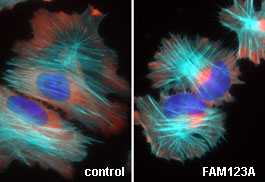Previously thought to only play a role in male fertility, the protein DAZAP1 has now been shown to be a major player in how genes are expressed; in cell culture experiments it stifled the progression of several types of cancer cells.
Researchers in the UNC School of Medicine found that the protein DAZAP1 plays a key role in the regulation of many genes through a process known as alternative splicing, and when highly expressed in cancer cell line experiments, DAZAP1 was shown to inhibit several types of cancer cells from dividing and moving.

The discovery, published in the journal Nature Communications, marks the first time this little-known protein has been characterized in relation to cancer development and tumor growth.
“If you knock down DAZAP1, then most of the genes involved in specific cancer cell signaling, cell death, and DNA repair are affected,” said Rajarshi Choudhury, PhD, a postdoctoral research associate in the department of pharmacology and first author of the study. “It’s a domino effect. DAZAP1 seems to be a sort of master regulator.”
The protein regulates how genes are spliced together before the genes produce the proteins that are involved in causing cancer cells to grow and divide. When there’s a lot of DAZAP1, cancer cells cease proliferating. “We’ve seen this in six different types of human cancer cell lines in the lab,” Choudhury said.
Its role as a master regulator is what makes DAZAP1 different from other proteins implicated in cancer and an exciting candidate for further research.
DAZAP1 is like a commanding officer; other proteins are like soldiers. Many cancer drugs target one of the soldier proteins that have already been expressed from a gene, have received marching orders from other proteins, and are well on their way to causing problems, such as metastasis. Potential cancer drugs that target such soldier proteins sometimes prove ineffective because in some cases cancer cells figure out how to circumvent those proteins and thus the drugs that target those proteins.
DAZAP1, though, is far up the chain of command. It helps organize the genes that will create those soldier proteins. It’s more of a decision-maker. Yet, Choudhury found that DAZAP1 can still be manipulated. His experiments suggest that certain kinds of cancer cells are able to “down regulate” DAZAP1 to allow the cancer cells to divide quickly and relocate. How the cells “down regulate” DAZAP1 is not known. In fact, how the protein becomes part of cancer cell biology isn’t well understood. That will require fully characterizing the protein and figuring out how DAZAP1 senses external signals like nutrients or growth factors that regulate its properties. This could open new avenues of research that will help scientists to better understand formation of certain cancer cell types and how they might be targeted.
DAZAP1 was unknown until 2000 when other researchers discovered the protein’s role in male fertility. Few scientists had researched the protein’s other potential roles in human biology. As a postdoc in the lab of Zefeng Wang, PhD, a member of the UNC Lineberger Comprehensive Cancer Center, Choudhury stumbled upon DAZAP1 while searching for proteins involved in alternative splicing – when a single gene organizes its genetic code to create different proteins with various functions.
Choudhury used high-throughput sequencing technology to find the targets of DAZAP1 and decipher whether DAZAP1 would bind to the exons and introns of genes. Exons are bits of genetic information along a strand of DNA. Introns are the spaces between exons. A single gene can make a variety of molecules depending on how exons and introns are spliced together. Choudhury wanted to study one of the proteins in the cell nucleus that binds to both exons and introns and thus plays a major role in how genes are spliced together to create the chains of amino acids that cause cells to act in specific ways, such as divide uncontrollably.
Another related paper published from the Wang lab indicated that DAZAP1 could bind to the introns as well as exons, but the molecular mechanism of DAZAP1 function was less understood at that time.
Choudhury and colleagues designed a series of experiments to find that DAZAP1 binds to a number of other proteins in the cell nucleus and promotes alternative splicing. By studying the cascade of intracellular interactions stemming from DAZAP1’s splicing function, Choudhury and colleagues determined that DAZAP1 was associated with the regulation of many genes that are involved in the creation of DNA, the synthesis of RNA, and the proliferation of cells – all of which are vital for cancer cells to proliferate and spread. More importantly, Choudhury and colleagues found that DAZAP1 directly links the regulation of gene splicing with the MAP kinase pathway – a key signaling pathway that controls cell proliferation.
“Why this protein is found in cancer cells is still a mystery,” Choudhury said. “But we now know that when DAZAP1 is overexpressed, the growth of cancer cells slows down significantly. We need to learn much more, but further research could lead to a drugable target.”
The National Institutes of Health funded this study. Zefeng Wang, PhD, associate professor of pharmacology and member of the UNC Lineberger Comprehensive Cancer Center was the senior author of the Nature Communications paper. Other authors include Lee M Graves, PhD, associate professor of pharmacology and member of the UNC Lineberger Comprehensive Cancer Center, postdoctoral fellow Sreerupa Ghose Roy, PhD, graduate student Yihsuan S. Tsai, and Ashutosh Tripathy, PhD, director of the UNC Macromolecular Interactions Facility. Choudhury is currently working with Michael Emanuele, PhD, at the UNC Lineberger Comprehensive Cancer Center.
